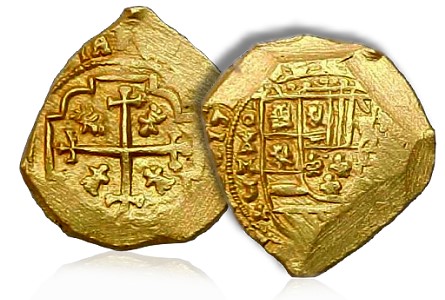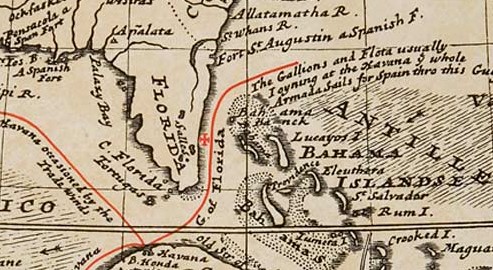By Phil Flemming and Ben Costello – 1715 Fleet Society …….
Prelude to History
In the early morning hours of July 31, 1715, one of the richest Spanish treasure fleets ever assembled was in trouble. Carrying a fortune in gold, silver, and jewels from Spain’s New World empire, the 1715 Fleet was trying to outrun an ominous storm pursuing it up the Florida Straits. The bulky treasure-laden galleons were not fast enough. By 2 a.m., 100-mph winds, torrential rains, and mountainous waves broke over the Fleet. A category 4 or 5 hurricane had caught the Spanish Treasure Fleet in the Florida Straits. They were trapped in the channel. They had nowhere to go.
Eleven of the 12 ships in the Fleet, including all of the treasure galleons, were lost, either capsizing in deep water or tossed upon the reefs and sandy shores off of the Florida coast. More than a thousand men and women, crew and passengers, perished with the ships in the fury of the hurricane.
 By dawn the next morning, the desolate beach was strewn with lifeless bodies and littered with wreckage. It was one of the worst sea disasters of all time. Bedraggled survivors became castaways along the Florida coast. The first order of business for them was to construct a make-shift camp. The survivors had barely any food or water. Shelter from the Florida sun and protection from hostile Indians was the priority until help arrived.
By dawn the next morning, the desolate beach was strewn with lifeless bodies and littered with wreckage. It was one of the worst sea disasters of all time. Bedraggled survivors became castaways along the Florida coast. The first order of business for them was to construct a make-shift camp. The survivors had barely any food or water. Shelter from the Florida sun and protection from hostile Indians was the priority until help arrived.
When the Spanish Colonial authorities heard of the disaster, they responded from Havana and St. Augustine, but it was more of an effort directed at salvaging the galleons than rescuing the survivors. As September rolled around, some survivors were still at the camp, which the Spanish authorities had turned into a base of salvage operations.
Using a clever system for salvaging ships in shallow water, the Spaniards were able to recover large portions of the treasure. There is some speculation that the Spanish exaggerated the amount of the recovery to deter unauthorized recovery efforts by Spain’s rivals. If so, it did not work. Pirates were almost as quick as the Spanish in responding to the disaster.
The British governor of Jamaica declared open season on the remaining sunken treasure. Survivors and salvors soon faced the additional peril of armed raids aimed at relieving them of the treasure they were trying to salvage. One English privateer named Jennings was especially successful in early 1716.
Lost and Forgotten
By the end of the next summer, the survivors, salvors, and pirates were long gone from Florida’s sandy shores. Winter had obliterated the wreck sites and the Spanish were apparently content with having recovered the majority of the treasure. But, in fact, a great fortune in treasure was still scattered along the Florida coast.
 Spain’s beleaguered monarch, Philip V, badly needed all the gold and silver that now rested in Florida waters, but his colonial agents could not reclaim it for him. The New World wealth that had made Spain a world power in the 16th and 17th centuries now had become a fraction of what it was, and Spain’s role in world affairs declined in proportion.
Spain’s beleaguered monarch, Philip V, badly needed all the gold and silver that now rested in Florida waters, but his colonial agents could not reclaim it for him. The New World wealth that had made Spain a world power in the 16th and 17th centuries now had become a fraction of what it was, and Spain’s role in world affairs declined in proportion.
Among the personal losses that Philip suffered from the Fleet tragedy were eight chests of gold and silver, as well as jewels designated as part of the dowry for his new 22-year-old wife. He had married Elizabeth of Parma by proxy in 1714 and was still trying to make a good impression on the reluctant lady. More than 1,200 pieces of rare jewelry from the Americas were being sent to Spain as dowry pieces for Elizabeth.
Her requests included a heart made of 130 pearls, 14-carat pearl earrings, a pure coral rosary with large-sized beads, and an emerald ring weighing 74 carats. The Queen’s dowry was stored in the personal cabin of the Fleet’s senior officer. Elizabeth, however, never saw any of it. This sunken treasure remained untouched for more than two centuries.
Enter Kip Wagner
The modern-day hunt for the 1715 Treasure Fleet began in the 1950s when a retired Florida contractor wondered why gold and silver kept washing up on a Florida beach near his home. Kip Wagner used to go beach-combing along the Florida coast looking for decorative pieces of driftwood. What he found instead was a treasure.
Wagner noticed that none of the coins that he found dated past 1715. Consequently, he started to research shipwrecks from that era. He also had a neighbor and good friend, Dr. Kip Kelso, who was an amateur Florida historian. They teamed up. Their big break came in 1959 when Dr. Kelso found an authentic 18th-century map of Eastern Florida. The map was published just 50 years after the 1715 Fleet disaster.
On the map, next to the Sebastian River, a specific notation stated “Opposite this River, perished, the admiral commanding the Plate Fleet of 1715….” This was the exact spot where Wagner was finding his coins. Wagner became convinced that a vast treasure in gold and silver lay scattered on the reefs just off Florida beaches.
More research identified the location of the salvage camp near the Sebastian inlet. Wagner purchased a $15 surplus mine detector and searched the area. He found a number of artifacts, including musket balls and a diamond ring. With this discovery, he knew that the shipwrecks were nearby. But how to go about salvaging the wrecks?
The Real Eight
Wagner was friends with a number of Air Force and NASA officers who were divers and closet treasure hunters. In 1960, Wagner partnered with some of these experienced divers. The first season of treasure hunting proved fruitless but the group soldiered on. Then on January 8, 1961, their luck changed. On that day, Wagner and his crew recovered over 2,000 pieces of eight. Shortly thereafter, a salvage company was formed that had eight members. They called themselves the Real Eight Company (named appropriately for the Spanish “ocho reales”, or piece of eight). By the summer of 1963, the members of Real Eight were convinced that they were on the trail of a great treasure – they were right!
Partnering with Mel Fisher
In May of 1963, Wagner and Real Eight faced the kind of dilemma most of us would like to face. A gentleman named Bruce Ward had found another gold-laden 1715 galleon just south of Ft. Pierce, Florida (about 70 miles south of the Sebastian inlet site Wagner was focused on). Real Eight did not have the resources to work both sites, but a man from California by the name of Mel Fisher wanted to join Real Eight.
Fisher had his own financing and crew so Wagner proposed that he work the Ft. Pierce site and partner with Real Eight. Fisher put a boat in the water at Ft. Pierce and by July 1964 hit the “Carpet of Gold”, a small area containing thousands of Mexican, Peruvian, and Columbian gold cobs. To this day, no recovery from the 1715 Fleet rivals the “Carpet of Gold” found in July of 1964.
Numismatic Significance of the Coins
National Geographic heard of the find and sent an agent to sign an exclusive first-disclosure deal with Wagner for their January 1965 issue. This issue is a classic among students of Fleet lore. Wagner took the deal but he had a problem. Most of his partners in Real Eight wanted to see some of the treasure sold immediately to recoup their investments. The compromise was an auction in October 1964 that featured some of the greatest numismatic treasures from the 1715 Fleet, but without explicitly identifying them as such.
 The auction was a great success nonetheless, and Real Eight prospered. Wagner and the members of the Real Eight Company did find the treasure that they were after. Many major auctions followed and slowly the treasure found its way into the numismatic community. Today, many collectors pay tens of thousands of dollars for prized gold doubloons and those strange bits of silver dated 1715.
The auction was a great success nonetheless, and Real Eight prospered. Wagner and the members of the Real Eight Company did find the treasure that they were after. Many major auctions followed and slowly the treasure found its way into the numismatic community. Today, many collectors pay tens of thousands of dollars for prized gold doubloons and those strange bits of silver dated 1715.
* * *
The “1715 Fleet Society” has been formed to coordinate events and promote awareness of one of the most important events in the history of Spanish Colonial Florida.
Phil Flemming is an author and noted historian regarding Spanish Colonial America. He has extensive numismatic knowledge regarding the treasure coins of the 1715 Spanish Treasure Fleet. To learn more about these coins, visit his website at goldcobs.com. Mr. Flemming resides in Phoenix, Arizona.
Ben Costello is a collector of Spanish Colonial Treasure Coins, especially those of the 1715 Fleet. He is involved extensively in the “1715 Fleet Society”, whose mission is to promote awareness of the 1715 Fleet disaster. Mr. Costello resides in Venetia, Pennsylvania.






I recently bought a 2 Escudo gold coin from the 1715 Treasure Plate Fleet and its a beautiful piece of history. It`s mounted in a pendant that I wear on my chain and I`m going to pass down it to my grand children for them to enjoy as well.
I got a 1489 silver dollar
I have a 1715 silver coin that I had a gold bezel wrap attached and an emerald so I can wear it as a token to show respect for the many that died because of the shipwreck.